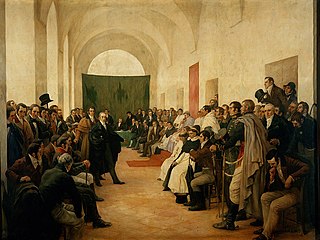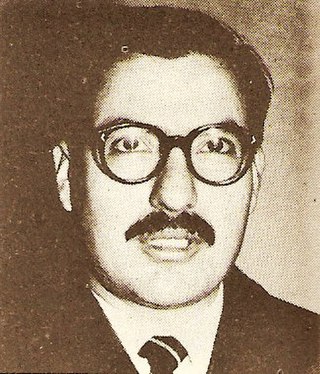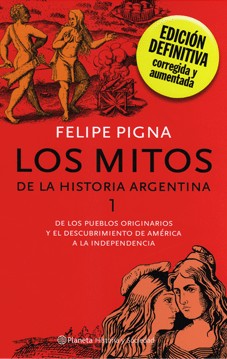
Bernardino de la Trinidad González Rivadavia was the first President of Argentina, then called the United Provinces of the Río de la Plata, from February 8, 1826 to June 27, 1827.

The May Revolution was a week-long series of events that took place from May 18 to 25, 1810, in Buenos Aires, capital of the Viceroyalty of the Río de la Plata. This Spanish colony included roughly the territories of present-day Argentina, Bolivia, Paraguay, Uruguay, and parts of Brazil. The result was the removal of Viceroy Baltasar Hidalgo de Cisneros and the establishment of a local government, the Primera Junta, on May 25.

The Primera Junta or Junta Provisional Gubernativa de las Provincias del Río de la Plata, is the most common name given to the first government of what would eventually become Argentina. It was formed on 25 May 1810, as a result of the events of the May Revolution. The Junta initially only had representatives from Buenos Aires. When it was expanded, as expected, with the addition of representatives from the other cities of the Viceroyalty of the Río de la Plata, it became popularly known instead as the Junta Grande or Junta Provisional Gubernativa de Buenos Aires. The Junta operated at El Fuerte, which had been used since 1776 as a residence by the viceroys.

Mario Ernesto O'Donnell Ure, known professionally as "Pacho O'Donnell", is an Argentine writer, politician, historian and physician who specializes in psychoanalysis.

Baltasar Hidalgo de Cisneros y de la Torre was a Spanish naval officer born in Cartagena. He took part in the Battle of Cape St Vincent and the Battle of Trafalgar, and in the Spanish resistance against Napoleon's invasion in 1808. He was later appointed Viceroy of the Viceroyalty of the Río de la Plata, replacing Santiago de Liniers. He disestablished the government Junta of Javier de Elío and quelled the Chuquisaca Revolution and the La Paz revolution. An open cabildo deposed him as viceroy during the May Revolution, but he attempted to be the president of the new government junta, thus retaining power. The popular unrest in Buenos Aires did not allow that, so he resigned. He was banished back to Spain shortly after that, and died in 1829.

The Infamous Decade was a period in Argentine history that began with the 1930 coup d'état against President Hipólito Yrigoyen. This decade was marked on one hand by significant rural exodus, with many small rural landowners ruined by the Great Depression, which in turn pushed the country towards import substitution industrialization, and on the other hand, by electoral fraud to perpetuate conservative governments in power. The poor results of economic policies and popular discontent led to another coup in 1943, the Revolution of 1943, by the Grupo de Oficiales Unidos (GOU), a nationalist faction of the Armed Forces, which triggered the rise to power of Juan Perón.

Fermín Chávez was an Argentine historian, poet and journalist, born in El Pueblito, a small town near Nogoyá, province of Entre Ríos. He studied humanities in Córdoba, philosophy in Buenos Aires, and devoted three years to the study of theology, canon law, archaeology and Ancient Hebrew in Cuzco, Peru.

The National Autonomist Party was the ruling political party of Argentina from 1874 to 1916.

Algo habrán hecho is a documentary film for television that narrates the history of Argentina. It was created by the Argentine historian Felipe Pigna, who acted as presenter. In the first two seasons Mario Pergolini was a co-presenter of it, but after giving up on all works on television his role in the documentary was taken by Juan Di Natale. Di Natale and Pergolini were by that time co-presenters of the talk show Caiga quien caiga. Di Natale pointed that he was not meant to act as if he was Pergolini, but the script writers wrote instead the scripts based on his own personality.
The Chuquisaca Revolution was a popular uprising on 25 May 1809 against Ramón García de León y Pizarro, Governor-intendant of the Intendancy of Chuquisaca. The Real Audiencia of Charcas, with support from the faculty of University of Saint Francis Xavier, deposed the governor and formed a junta. The revolution is known in Bolivia as the "First Cry of Freedom", meaning the first phase in the Spanish American Wars of Independence. The level of hostility against the Spanish Crown and news from both the American Revolution and the French Revolution has made historians dispute on whether such a description is accurate. However, accounts depict it as being the first step towards liberty in Latin America against the Spanish Crown.

Los mitos de la historia argentina is a series of books written by Felipe Pigna, focused on the History of Argentina. As of 2010 the series have four books, which span from the Spanish arrival to America up to the governments of Juan Domingo Perón.
The Historiography of Argentina is composed of the works of the authors that have written about the History of Argentina. The first historiographical works are usually considered to be those by Bartolomé Mitre and other authors from the middle 19th century.

Historiographical studies of the May Revolution started in the second half of the 19th century in Argentina and have extended to modern day. All historiographical perspectives agree in considering the May Revolution as the turning point that gave birth to the modern nation of Argentina, and that the Revolution was unavoidable in 1810. The main topics of disagreement between Argentine historians are the specific weight of the diverse causes of the May Revolution, who were the leaders of it among the different involved parties, whenever there was popular support for it or not, and whenever the loyalty to the captive Spanish king Ferdinand VII was real or an elaborate masquerade to conceal pro-independence purposes.

The May Revolution was a week-long series of revolutionary events that took place from May 18 to May 25, 1810, in Buenos Aires. It started the Argentine War of Independence, and it is considered the birth of modern Argentina.

The historiography of Juan Manuel de Rosas is highly controversial. Most Argentine historians take an approach either for or against him, a dispute that has influenced much of the entire historiography of Argentina.

Argentine nationalism is the nationalism of Argentine people and Argentine culture. It surged during the War of Independence and the Civil Wars, and strengthened during the 1880s.
Events in the year 1905 in Argentina.

Laura Malosetti Costa is a Uruguayan-born Argentine social and cultural anthropologist, researcher, art historian, and essayist. She is also a curator of art exhibitions and the author of several books on Latin American art. She was recognized with the Konex Award in 2006 and 2016.

Ángel Viñas Martín is a Spanish economist and historian. He has published many works dealing with the Spanish Civil War focusing on the war finance as well as the international relations aspects of the conflict.

Héctor Benigno Varela was an Argentine military officer, best known for having been responsible for the massacre of between 300 and 1,500 workers in the Santa Cruz province, during the events that became known as Patagonia Rebelde.

















